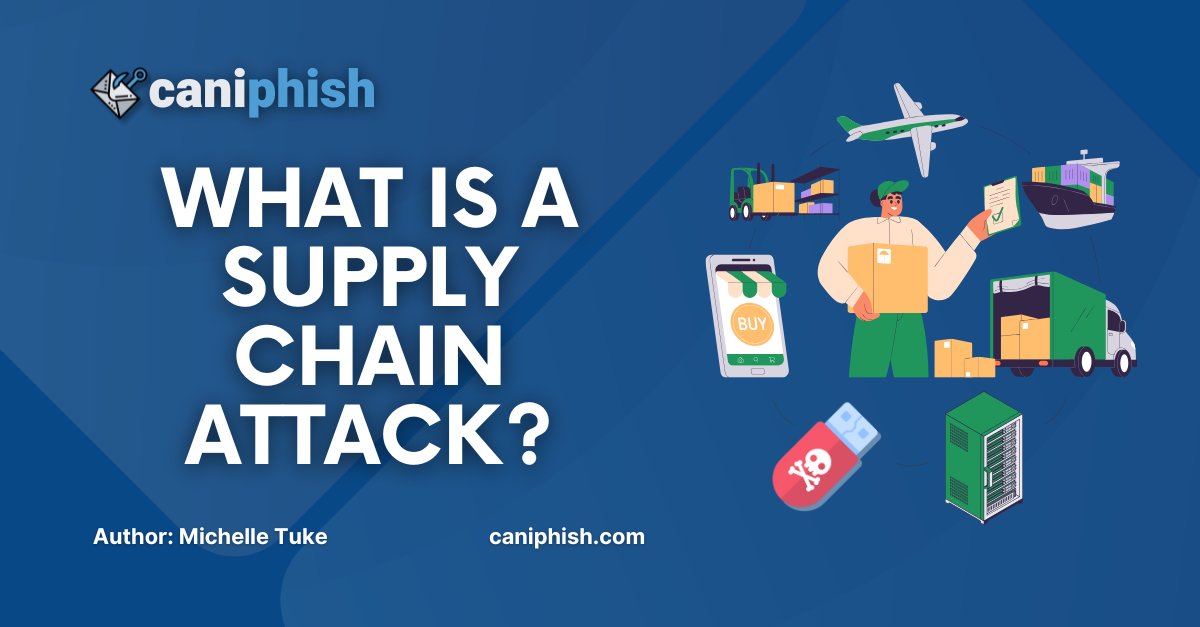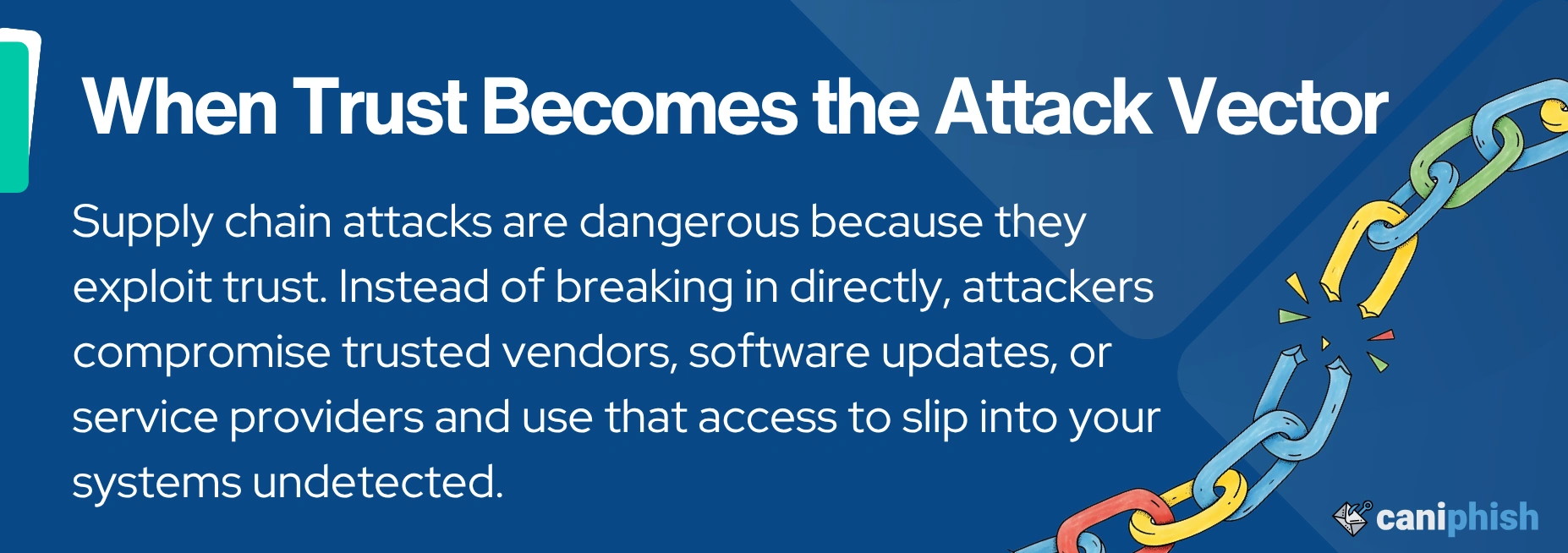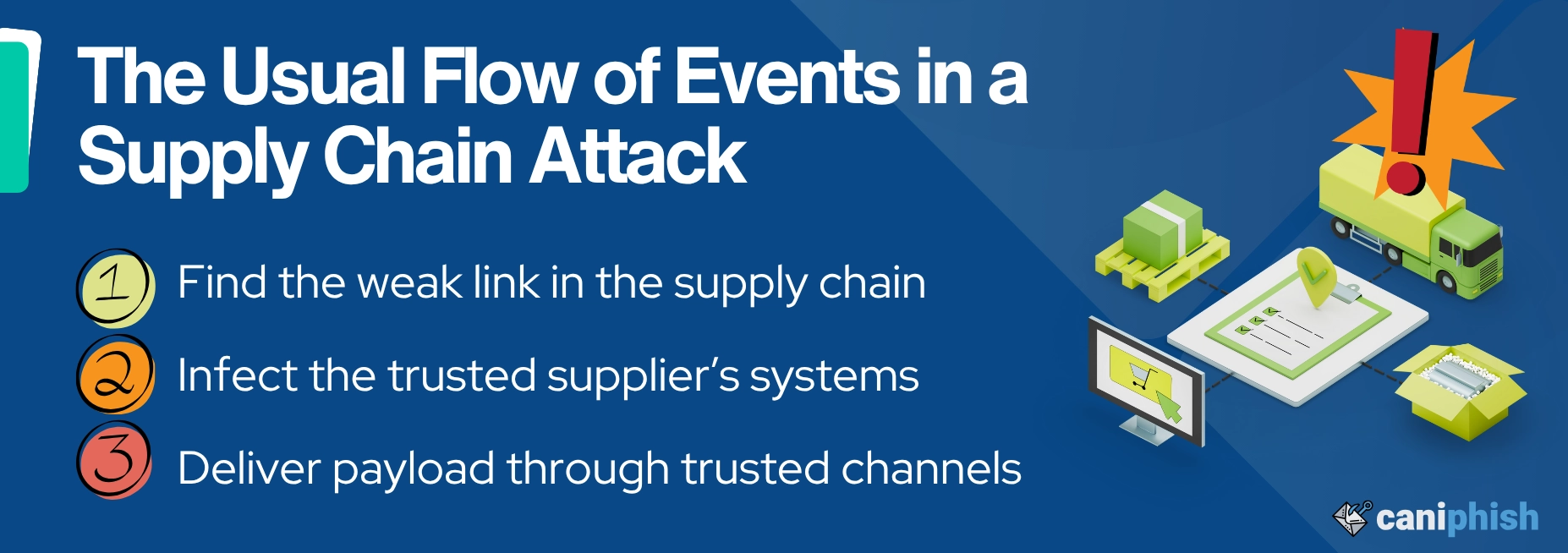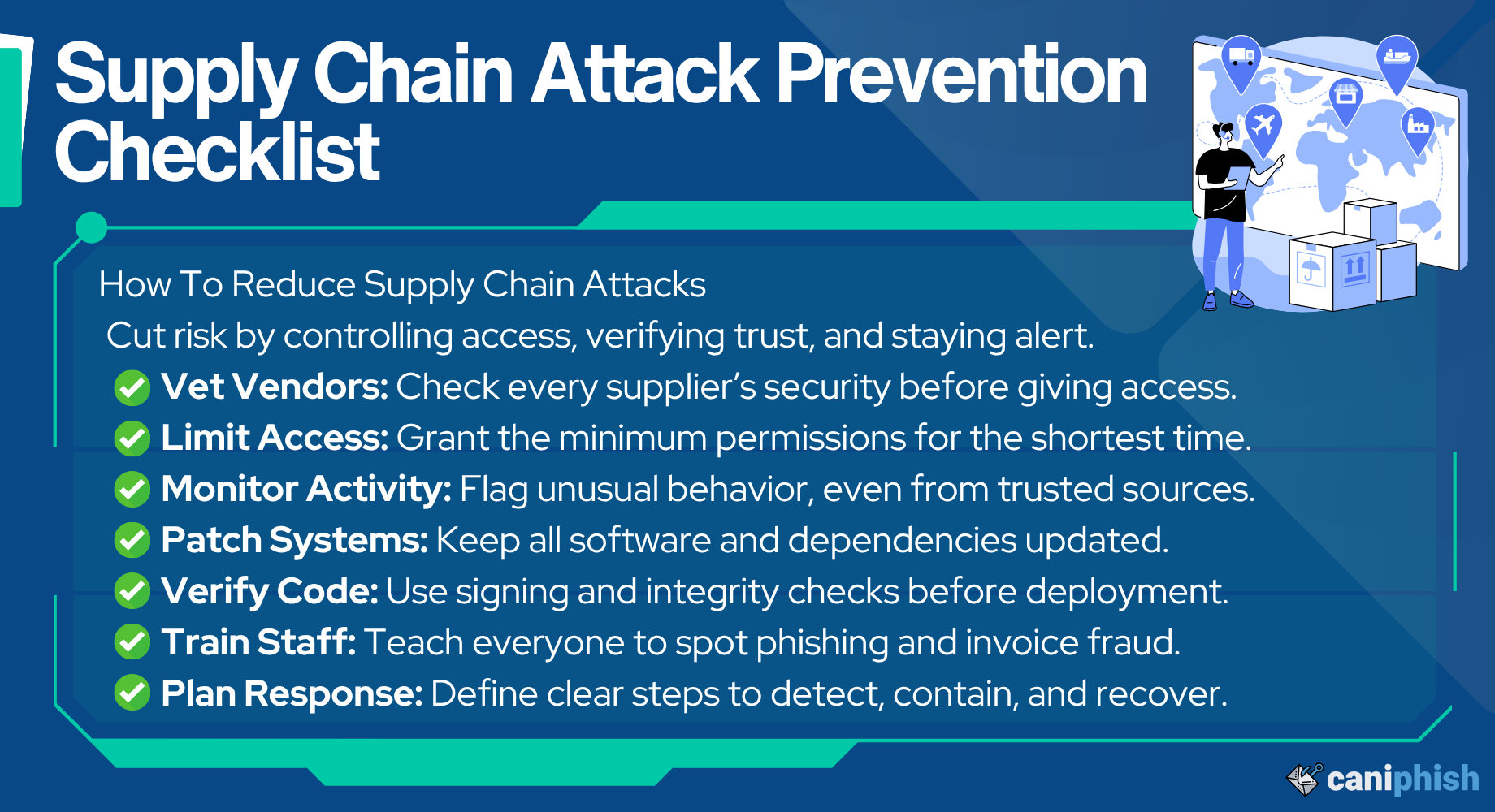What Is A Supply Chain Attack?

A supply chain attack is when cybercriminals target a company by exploiting weaker links in its supply chain, like third-party vendors, software providers, or service partners.
Why Are Supply Chain Attacks So Dangerous?
Supply chain attacks are dangerous because they exploit the one thing they are built on, trust!
As an organization, you tend to trust third-party companies to do the right thing: software vendors to provide clean updates, delivery companies to ship your goods, and logistics providers to keep systems up and running smoothly.

You rely on contractors to maintain your equipment, and on platforms like booking systems, payroll software, and payment processors to keep operations moving.
Attackers don’t need to force their way in, they slip through someone you’ve already let inside.
How A Supply Chain Attack Works
Attackers compromise trusted third parties and use that access to quietly reach their true target. Here's how supply chain attacks typically play out:
-
Find The Weak Link
Hackers do their homework on an organization and identify a smaller third-party vendor that's connected to them. These smaller companies often have weaker security, making them an easy target.
-
Infect The Supplier
Once the weak link has been found, the attackers breach the supply system with malicious code, fake credentials, or plant backdoor entry points.
-
Trusted Delivery
The supplier is trusted, so any software updates, systems access, or data transfers from them are usually accepted without question. Exploits and malware are delivered undetected, and it's business as usual.

How Attackers Breach The Supply Chain
Supply chain attackers don't just focus on one weak link, they look for vulnerabilities across physical, digital, and operational layers:
Cyber Attacks
Hackers go for the online targets like software vendors, APIs, code libraries, and cloud services.
- by inserting malware into software updates
- through exploiting third-party access to internal systems
- compromising trusted communications to phish employees
Physical Attacks
These attacks may tamper with physical goods in transit.
- stealing or swapping the legitimate shipments
- hardware inserted with rogue microchips
- fake courier pickups or spoofed delivery routes
Operational Exploits
This includes insider threats and human error.
- manipulating or bribing employees
- exploiting poor access control or vetting processes
- targeting trusted vendor staff with high level access
Hybrid Threats
These are attacks that cross from the physical world into the digital one or vice versa.
- hacking Internet of Things (IoT) to manipulate physical data
- attacking Operational Technology (OT) to disrupt industrial systems
- using physical and phishing breaches to gain hands-on access
Types of supply chain attacks
Supply chain attacks take many forms. Below are the most common types and how they work.
Malicious software updates
Attackers disguise tampered updates as legitimate patches, delivering hidden malware through trusted software channels.
Compromised app libraries
Malicious code is inserted into third-party libraries, infecting every application that uses them without detection.
Rogue firmware or hardware chips
Attackers embed backdoor-loaded microchips or compromised firmware during manufacturing to gain persistent access.
Spoofed invoices and emails
Cybercriminals impersonate trusted vendors or executives to trick employees into paying fake invoices or installing malware.
Who Do Supply Chain Attacks Target?
Anyone in the supply chain is fair game because breaching one can give access to hundreds or even thousands of victims downstream. Here are the common targets:
- Third Party Service Providers: Outsourced IT, billing, or logistics teams are frequent entry points.
- Software Vendors: Attackers tamper with software updates or third party libraries to spread malware.
- Trusted Suppliers or Contractors: Electricians, maintenance teams, or even office cleaners can be targeted to gain physical or network access.
- End Users: Employees who click on phishing emails or download malicious attachments often trigger the attack chain.
How Can Supply Chain Attacks Be Reduced?
Reducing supply chain attacks means keeping a close watch on every person, process, and piece of technology connected to your business. Here's what works:
- Vet Your Vendors: Know exactly who you're dealing with and review their security posture before granting access.
- Limit Third Party Access: Restrict access to only what’s necessary and for only as long as required.
- Monitor For Strange Behavior: Use monitoring tools to detect unusual activity, even from trusted sources.
- Patch And Update Everything: Keep systems, software, and dependencies up to date with the latest security fixes.
- Use Code Signing And Intrusion Checks: Verify that software hasn’t been tampered with before deploying it into your environment.
- Train Your Team: Security training applies to everyone, not just IT. Teach staff how to spot phishing, invoice fraud, and suspicious requests.
- Have An Incident Response Plan: Establish clear steps for identifying, containing, and recovering from a supply chain breach.

How Is AI Helping Attackers In Supply Chain Attacks?
AI is helping attackers by making supply chain attacks faster, smarter, and harder to stop. Common uses include:
- Automated Reconnaissance: AI quickly maps an organization's digital supply chain, finds weak vendors, outdated systems, and exposed credentials.
- Phishing At Scale: AI generates hyper personalized emails and voice messages with no grammatical errors so attackers can convincingly impersonate suppliers or executives.
- Malware Evasion: AI tweaks malware in real time to avoid detection and adapt to defenders' responses.
- Synthetic Identities And Deepfakes: AI creates convincing personas, fake invoices, and deepfake video or audio to manipulate trust.
- Automated Exploit Deployment: Once a vendor vulnerability is found, AI automates exploitation and scans for the same weakness across other clients.
Supply Chain Attack Risk Assessment
A supply chain attack risk assessment is a structured process used by organizations to identify, evaluate, and mitigate cyber security risks from third-party vendors, suppliers, and service providers. It's a critical step to keeping your organization safe, as one weak link outside the walls can be all it takes to let an attacker in.
Here's some questions your organization needs to asking;
- What level of access do they have to your systems or data?
- What security controls do they have in place
- Have they been attacked before?
- How do they handle vulnerabilities and incident response?
- Do they vet their supply chain?
Step Into The Mind Of A Hacker
The Social Engineer is a high-stakes, turn-based cyber game where you play as an up-and-coming criminal mastermind.
Play now!Frequently Asked Questions
Can One Supply Chain Attack Affect Many Businesses At Once?
Absolutely. One breach can ripple through thousands of businesses in one sweep. It's the butterfly effect in action. Compromise one supplier, and the damage cascades downstream to every organization connected to them.
Real-World Examples Of Supply Chain Attacks?
In 2020, hackers planted a backdoor called SUNBURST into the SolarWinds Orion software platform, compromising the supply chain. This allowed attackers to access thousands of networks. The tainted update was downloaded by around 18,000 organizations, including US government agencies and Fortune 500 companies, making it one of history's most infamous and far-reaching supply chain attacks.
Supply Chain Attack Vs Direct Attack?
The main difference is the path it takes. Supply chain attacks exploit someone the target trusts, while direct attacks go straight for the victim, excluding any middleman.
An example of a direct attack would be attackers sending a phishing email to an employee at a large corporation in finance, tricking them into handing over their login credentials.
